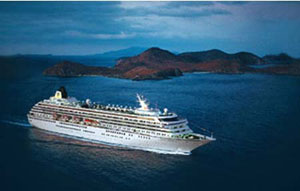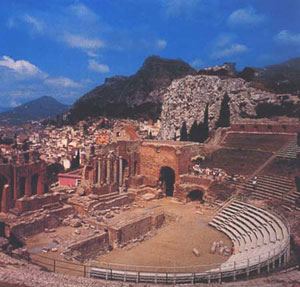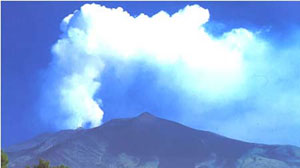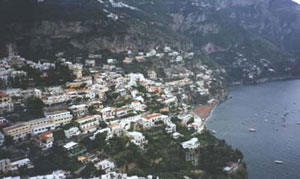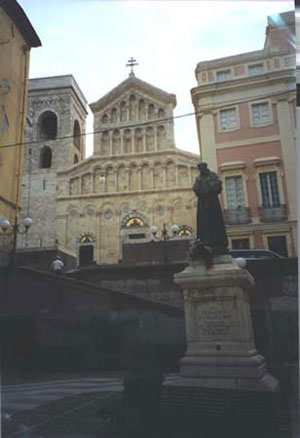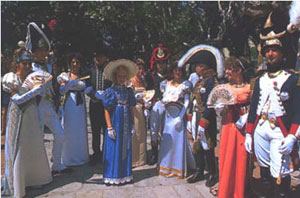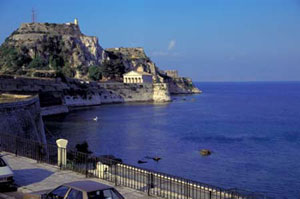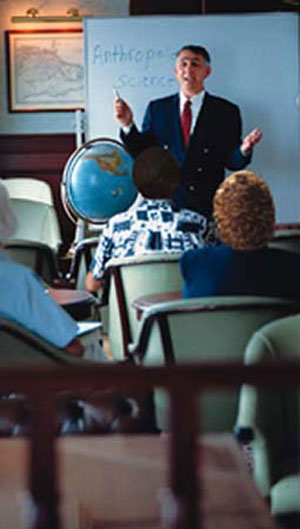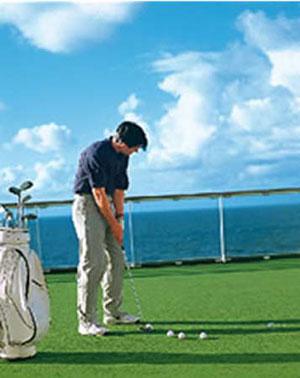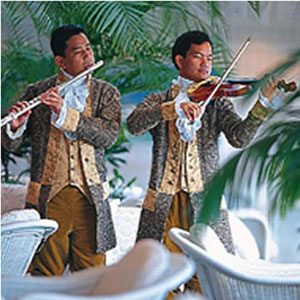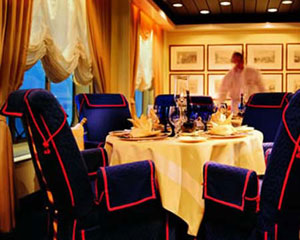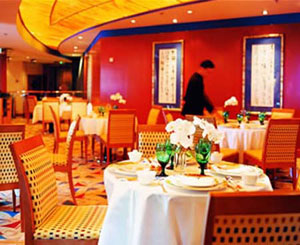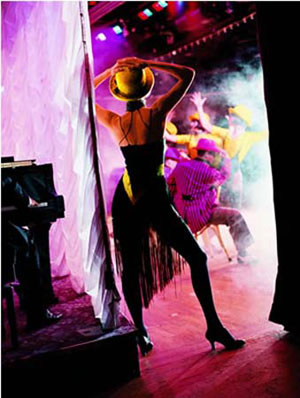 |
|
|
|
|
|
|
|
|
|
|
|
|
|
|
|
|
|
|
|
|
|
|
 |
 |
|
|
|
|
|
|
|
|
|
|
|
|

|
Cruising the Mediterranean Aboard the Crystal Symphony
Empires of the Ancients Some say it’s the light—a singular, rich light that appears just about everywhere as twilight descends in the Mediterranean. But whether it’s the brilliance of the sky and sea, the fabled towns or the millennia of history and culture, the Mediterranean is a splendid spot to vacation. Why aboard a cruise ship rather than by land? Cruising bundles a lot of travel and a generous amount of relaxation into one package. Because the region’s scenic wonders and celebrated cities are on or close to the water, visiting by ship gets you right to the coast and islands.
In planning the itinerary for the 12-day 2002 late summer voyage "Empires of the Ancients," Crystal Symphony provided a trove of lore about the foundations and paths of civilization in eight significant Mediterranean centers. With ruins that date from the 9th century BC, settlements that were born 20,000 years ago and sites that figure in Greek mythology, even the most passionate students of history, art, archeology and religion were excited by the wealth of information gleaned from shore excursions, on-board lectures by historian Martin Blinder, closed-circuit travelogues and hand-outs. Many cities might claim supremacy in the Ancient World, but surely Athens can confidently avow to be a rightful heir to the title. And thus, the starting point for the sojourn befittingly was Piraeus, the port of the capital of Greece and gateway to the Mediterranean since 482 BC. "Athens," John Milton proclaimed, "the eye of Greece, mother of arts and eloquence." Some passengers arrived in the city of embarkation the day before, stayed overnight at the cruise’s selected hotel and chose one of two tours before being transported to the boat. One concentrated on the National Archeological Museum, housing a fine and most extensive collection of Greek antiquities. Free time to roam the Plaka neighborhood in the center of the old city followed lunch. Another, a drive along the Saronic Gulf, ended at the Temple of Poseidon perched precipitously on a rocky bluff near the edge of the Aegean. Several years back I traveled independently to this spectacular temple, where the Ancient Greeks worshipped Poseidon, God of the Sea. Buses use both the coastal and inland routes to the cape.
For me the most substantive experience in Athens is to revisit the Acropolis unfettered so as to side step the hordes following someone hoisting an umbrella on high and to see once more the white marble of the Parthenon shimmering in the sun. Pericles, who considered the city the citadel of the gods, built the Acropolis to proclaim the ascendancy of Athens as the greatest city on earth. In describing those stones Plutarch said they were "untouched by time, as the unfaltering breath of an ageless spirit had been infused in them." Like Athens, Taormina is not directly on the water, but is accessible from Sicily’s first Greek colony, the port of Giardini Naxos. The museum here houses relics uncovered from an archeological site. Sightseers found it easy to wander about on their own in Taormina as the ship scheduled frequent tenders to shore and shuttle buses to town. Although today the city is primarily a crowded resort, its history is rich—Pliny the Elder praised Taormina’s wines and Ovid wrote of the "sweet mullet and tender eels" in the nearby Ionian waters. Throughout the centuries Greeks, Romans, Arabs, Byzantines, Phoenicians, Saracens, Normans, Argonese and Bourbons came to conquer or take up residence and left an imprint on the architecture and culture.
Renowned for its width and acoustics, the Corinthian-pillared Greek amphitheater is the city’s oldest reminder of a previous civilization. The Odeon, 21 BC, is a small Roman theater behind Palazzo Corvaia, whose tower was erected by the Arabs in the 11th century. It was the site of Sicily’s Parliament in the 15th century and best illustrates a local custom—the use of black and white lava and pumice on facades. Examples of structures that were erected in the 16th century, but whose foundations sit atop early ruins, are the churches, San Pancrazio, transformed from a Greek cello, and Santa Caterina, perched on stones from Odeon. To see Mt. Etna, Europe’s highest active volcano, which looms over Taormina and has been gushing lava for half a million years, sign up for the ship’s tour. The height of the summit, presently about 10,800 feet, changes with each eruption. In ancient times Etna was believed to be the realm of Vulcan, the god of fire, and the home of Cyclops, the one-eyed monster. After reaching the lower levels of the mountain, 6,200 ft. above sea level, you can explore the Silvestri Craters and peer into some of the caves.
The Straits of Messina bordering Giardini Naxos connects to the Tyrrhrenian Sea and links Taormina with Sorrento further up the coast on Italy’s mainland. Etruscans, Greeks and Carthagians fought for domination of these waters. The stop in Sorrento, starting point for several destinations, offered the best of opportunities for serious scholars of antiquity, but singling out one was difficult. Even the excavation sites offered a challenge—Pompeii alone or this most important archaic site and Herculaneum, too, both of which were engulfed by ash and cinders when Vesuvius erupted in 79. Pompeii comprises an almost perfectly preserved Roman town and smaller Herculaneum contains homes of the wealthy where artifacts illustrate an extravagant lifestyle.
The Amalfi Drive tours also required some decision-making whether to explore Ravello and Positano or instead head to Amalfi. Both provided a fascinating and fearsome drive on the winding, improbable road carved on the verge of the abyss and banded by high mountains falling sharply into the blue sea. Modern Positano bears few signs of its power as a trading center 1000 years ago. But you can see a bit of the 18th century in the Neapolitan baroque Palazzo Murat, now a hotel, where Napoleon’s brother-in-law summered. In Ravello, the best sights, the 11th-century Villa Rufolo and Villa Cimbrone, combine medieval and classical styles. Among the churches, the Cathedral begun in 1807, Chiesa del Toro and San Francisco Cloister deserve mention. In Amalfi, history has left solemn marks: the strikingly beautiful 11th-century cathedral and the cloister, Chiostra del Paradiso. To reach Capri, the sumptuous island near Sorrento, take the hydrofoil or ferry at the pier after debarking from the tender. Even in Capri, settled by Caesar Augustus in 29 BC and where life often resembles a Fellini movie, the past invades the present. Establishing himself in 12 villas, one for each deity, Augustus’s son, Tiberius, lived a life of debauchery. To sense his might, visit Villa Jovis, his headquarters for a decade. La Certosa, a monastery dating from the 1300s is of interest because its friars ruled here for centuries. The garden is open to the public. Ruins of two medieval castles, Castello di Barbarossa and the Castiglione, remain as does the oldest church, San Costanzo.
In Sorrento, itself, you see the classic arrangement of a Roman city—a well-preserved gate at Marina Grande, the city wall, Porta Parsona Nuova, and some stones from the era, as well as the 14th- and 15th-centuries Correale Palace and Romanesque Cathedral. After sailing 269 nautical miles from Sorrento, the ship arrived in Sardinia and docked in Cagliari, the capital of this second largest island in the Mediterranean. From here it took under an hour to reach Nora, a small city of extraordinary ruins and the oldest one in Sardinia. Settled by Phoenicians, who were followed by Romans, the ruins are well-preserved—a semi-circular amphitheater, circa 2nd century and accommodating 10,000; a museum dedicated to the singer and orator, Tigelleius; paved roads; temples and bathhouses built with striking mosaics. If you decided to stay in Cagliari, your history lesson was equally enriching. Narrow streets and steps (and elevators, too) connected by piazzas at frequent levels line the hills rising from the harbor to the upper town. Wander this enigmatic medieval district, the Costello, enclosed by 13th-century ramparts and the site of two defensive towers, Elefante and San Pancrazio. The city is blessed with museums, one of most interesting being Cittadella dei Musei, a consortium of four different collections. The principal religious monuments are the Archbishop’s Palace, the domed Basilica di S. Saturnino and the Sant’Elfisio and St. Cecilia Cathedrals.
From Sardinia we sailed to Corsica, a French province for almost two and one-half centuries, which is closer on the map to Italy than to France. The people’s obsession with all things Napoleon notwithstanding, the culture here is not European, but rather Mediterranean. Ajaccio, the principal city and a pleasant enough place to walk, is crowded with memorabilia honoring General Bonaparte. A full-day excursion on the coast of the island and into the interior included stops at several villages. Although scenery was the main attraction of this sojourn, you find traces of Greek immigrants fleeing the Ottoman Empire in Cargese and vestiges of the Roman Empire at the Genoese Tower and Saint Appiana’s cathedral in Sagone. Like the previous ports of call, Corfu, the farthest north of the seven Ionian Islands, shows the deep influence of centuries of invaders. Homer wrote about it in the "Odyssey" as the place where Odysseus was shipwrecked. Jason and the Argonauts also found refuge on Kerkira during the quest for the Golden Fleece. The first non-mythical inhabitants were Corinthians.
Corfu Town is the major city and as you traverse its main and side streets, notice the many dissimilar elements in the architecture—the Liston, a French arcade, Italianate homes, Georgian mansions and wrought-iron Venetian balconies—left behind by all who colonized the island. The Old Fortress, the original settlement, is cut off from town by a moat. This citadel where the populace lived for several hundred years was founded by Byzantines and later expanded by Venetians. The Town Hall is also attributed to the Venetians. The Archeological Museum houses treasures from the Mycaenean period. Two Byzantine churches—St. Jason and Sossipater—have fine frescoes, but the one dedicated to St. Spyridon, Corfu’s patron saint, is the most revered and has priceless icons and the saint’s sarcophagus. The last two ports, Dubrovnik and Venice, have resisted the intrusion of modern architecture more than the earlier ones on the itinerary. The old town in Dubrovnik and much of Venice are living museums and appear as they did in the Middle Ages. Dubrovnik, gem of Croatia’s Dalmatian coast, is a prototype of what illustrators of fairy tales might have imagined—a walled Medieval village with gates, ramparts, fortresses and turrets. Although there is a small archeological site, it is the construction dating from the 12th to the 17th century that impresses. If you enter through the Pile Gate and cross two bridges you reach a center thoroughfare, the Placa or Stardun, which stretches to the Ploce Gate and whose limestone paving shines after the rain like glass . A walk at a cool time of day along the ramparts is a must. It begins with a climb up an 80-foot high staircase and consumes about 1½ hours to cover the entire length of the wall. The panoramic view takes in the sea below filled with swimmers and sailors, the terra cotta roofs and the fortresses of St. John’s, Minuets and Botar.
Each attraction seemed to have something of special interest: the Franciscan Monastery, housing an old pharmacy and a museum of priceless objects;Spinoza Palace, arranged as a two-storied cloister; Rector Palace, perhaps the choicest building in the old town; St. Blase, a baroque church, whose main altar holds a gilt statue of the saint; and the Cathedral, a three-hall building, containing a rich repository of old masters, such as Titan, Andrea del Sarto and Rafaela. Because the ship did not sail until 11 p.m., it was possible to spend the evening in town. After dark when the lights are turned on, Dubrovnik is even more spectacular than when the sun shines. The old buildings sparkled as if dressed for a celebration. No one seemed to know how many (there are hundreds, to be sure) cafes, bars and restaurants are in the old section. There was not an empty seat as people ate, drank, listened to music and partied hard. Travel writers must leave it to painters and poets to describe the beauty that is Venice. To express to one's fullest the richness, light, color, texture and history of the grace and elegance that is La Serenissima (the serene one), one must possess that rare artistic talent. Founded 1,300 years ago, it was by the turn of the last millennium, one of the world’s richest cities. Built on a patchwork of more than 100 low-lying islets in a swampy lagoon and intertwined by a maze of 150 narrow canals and 400 lacy bridges, it had taken on much of its present shape by 1500 and is frozen in time. The vaporetti, which ply the Grand (main) Canal, circumnavigate the periphery of town, motor through the lagoon and link the outer islands, are the most enjoyable form of public transportation anywhere. To ride the entire stretch of the Grand Canal take the No. 1 (local) or the No. 84 (express) and, if possible, sit in the front open-air section of the boat. From the top of the Campanile (Bell Tower), where in 1609 Galileo demonstrated his telescope to a doge, visitors enjoy a sublime view of the city and the lagoon. There are so many attractions and so much to absorb at every turn that only a few are listed here. Piazza San Marco described by Napoleon as "the most elegant living room in Europe" has been the heart of the city since the founding days of the Serene Republic. Dominating the square are the Basilica and Palazzo Ducale. The best time to visit them is at the opening when the crowds are thin. An audio tape makes a useful companion for a self-guided Doge’s Palace tour. Six ancient administrative districts or sestieri form central Venice. To discover Venezia Segreta, secret Venice, walk through the lesser-known quarters. A stroll on a single calle (narrow street) could uncover new treasures. Venice, Wizard of the Sea, casts a spell on all who visit her. As the port of debarkation, magical Venice tempered any sadness in saying good-bye to the glamour of Crystal Symphony. If I had a quibble with the cruise, it would be that there wasn’t enough time during sea days for all the activities. As I leaf through my copies of "Reflections," the daily newsletter that included the schedule, staff bios, the dinner dress code—casual, informal or formal—and more, I recognize how each day was designed to provide great enjoyment to passengers with a wide range of interests.
My husband, Ed, is a history and political buff. The Crystal Visions Enrichment Series was tailor-made for him and he attended every lecture. James Fallows, national correspondent for "The Atlantic Monthly", and Dr. Martin Blinder, Mediterranean basin specialist, delivered respectively multiple speeches on today’s political atmosphere and the ancient history of the area. Included in the series were also talks by a decorative arts expert from Sotheby’s and a NASA photographer. Ed doesn’t know as much about wine, but that didn’t deter him from attending the tastings conducted by oenologist, Stephen Mutkowsi, which are part of the on-going Crystal Wine and Food Festival. On this voyage guest chef Alain Sailhac, also a festival participant, gave a demonstration and his signature dishes appeared in the dining room. Although I detached myself from my obsession with the internet and email during the voyage, others did or could not. Crystal’s Computer University@Sea not only solved the problem of separation anxiety from your computer, but gave passengers an opportunity to learn new skills. Four lectures and four classes were offered. Every guest was given a private email address and the opportunity to set up a personal website to publish photos from their own digital camera, the ship’s webcam or by converting 35mm film to a CD-ROM. If you trade stocks via the internet, you could do it on board, too, or at least follow your investments. Odyssey Art at Sea met regularly for instruction in painting with water colors. Origami and needlepoint lessons were also offered as well as all levels of bridge and dance instruction. You could tour the galley with the executive chef, look behind the scenes of the productions or listen to performers discuss the acting process. Gaming lessons were designed to help you improve your chances of winning at the casino’s tables. Crystal is the only cruise line whose casinos, Caesar’s Palace at Sea, are operated by the Las Vegas company.
Back in the good old days quoits and shuffleboard on deck were considered strenuous exercise with no sports and fitness directors in sight. But on Crystal, table and paddle tennis classes were scheduled, as well as golf lessons conducted by a pro at the putting green and driving nets on Sun Deck 12. Several exercise classes—step aerobics, stretch, cardio ki bo, body sculpt, aqua moves in the pool and pilates—were held daily. And back in the old days hair styling and manicures were the thing at on board salons. With salons evolving into spas, aesthetic treatments are now the rage. Crystal’s ships are the only ones afloat whose spas were designed using the art of placement, feng shui, which literally means wind and water. The Chinese believe that this practice leads to a free flow of ch’i (life force). Feng shui principals are incorporated into rituals, individual esoteric therapies and ceremonies combining several exotic treatments lasting from 3 ½ to 6 ½ hours. "I believe you have not experienced these treatments yet on Crystal," Jody Moore, manager of special projects for Steiner Transocean Ltd., operators of the spa, told me. And despite being a devoted spa-goer, I hadn’t. A 90-minute Aroma Stone Therapy combining traditional massage, aromatherapy and heated volcanic basalt stones fostered total relaxation. A Japanese Silk Booster Facial using Japanese silk protein compresses left my skin glowing and healthy. I wrote to Jody saying, "Those treatments were delicious."
The international crew was unfailingly courteous and professional. Many of them knew our names immediately. Some key personnel said they remembered us from an earlier cruise. (Well, even if they didn’t, they were great at p.r). With a passenger capacity of 940 and a staff of 545 it’s one of the highest guest-employee ratios on the seas. It was like having a houseful of help, butler included if you were on the penthouse deck. Crystal Symphony’s sense of luxury comes not from eye-grabbing architecture, but rather from a fine attention to detail—Riedel crystal wine glasses, Wedgewood bone china cups, Frette table linens, Brown Jordan Mission teak deck furniture, Dundee bath towels, English mohair lap blankets, Villeroy & Boch china, Sambonet and Elkington silver, Scandinavian comforters, goose down pillows, Callaway golf equipment and wide wraparound teak decks. The design is understated. Although the ship was built before the line was taken over by a Japanese company, no doubt the simplicity appealed to the new owners. Because of the high space-to-passenger ratio, there is no sense of crowding.
Mealtimes were, of course, the social hubs of the day especially the two dinner seatings in the main Crystal Dining Room. The quality of the food at breakfast, lunch, dinner and tea was without par and the range of choices was staggering. Who wouldn’t be happy eating caviar whenever they wished? Theme meals were frequent with three exquisite lunch buffets—an Asian Cafe, Cuisine of the Sun representing 14 Mediterranean lands and a Grand Gala Buffet groaning with almost too many selections. Evening motifs included the '50s, Neptune dinner on deck, French, Guest Chef, Mediterranean and a Medieval Royal Feast, the most lavish one of all. Dining room staff dressed in opulent period garb served a menu fit for a court banquet. Even the genteel afternoon teas were imaginative. At the Mozart tea continental pastries were offered and at the English Colonial one appropriate sweets and savories were presented. You could dine-around-the clock with 24-hour room service and in a variety of informal venues. Crystal pioneered adding small restaurants as an alternate to all-hands-in-the-dining-room dinners. Venetian-style Prego had a terrific Italian menu and a tasting one, which evolved from a collaboration with the famous Valentino restaurants. Jade Garden served Asian specialties and used some of Wolfgang Puck’s recipes from his Chinois chain.
Broadway-type production shows headed the entertainment roster. There were stunning costumes, quick changes, imaginative sets and multi-talented performers. The hauntingly impressive "Excalibur, An Evening in Camelot," was my favorite among the five musicals. A troupe of actors, "Repertory at Sea," performed excerpts of comedy, drama and farce from the works of famous playwrights. Instrumentalists, vocalists and pianists played music alone or with a trio, quartet or orchestra in a variety of venues all evening long. At the Hollywood Theatre recently released movies were projected twice each day. Nightly dancing took place in the main lounges and nightclubs. Several bars offered intimate settings in which to have a drink.
Ships are great places for easy friendships and on-going conversations. As the journey wound down we exchanged smiles, hugs, handshakes, business cards and the words, "wonderful to have met you," with our new pals. At Christmas we’ll undoubtedly hear from many of our shipboard buddies, a pleasant reminder of our special days together on Crystal Symphony. Reservations: 800-446-6620 www.crystalcruises.com Fall 2002 |
||||||||||||||||||||||||||||||||
